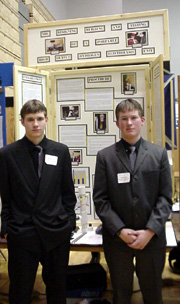|
Young Scientists from
Sunburst�
Win NCAT Sustainable Energy Award
The science project chosen for
the NCAT Sustainable Energy Award in 2003 "is an
excellent example of international cooperation,"
according to the engineer who chose the winner.
The project, titled "The
Designing, Building, and Testing of a Portable High Output
Hydrogen Electrolysis Unit," was the work of two North
Toole County High School students, one a U.S. citizen and the
other Canadian.
Dan Cox is a senior from Kevin,
Montana, while Cody Ford, a junior, is from Coutts, Alberta,
Canada. Both attend North Toole County High School in
Sunburst, a small town about 25 miles north of Shelby and
eight miles south of the U.S.-Canadian border. The two built
and tested a hydrogen generator.
Sustainable Energy Award judge
Ray Schott, an NCAT engineer and renewable energy specialist,
said he was impressed by the presentation that Cox and Ford
made at the State Science Fair in Missoula April 7.�
According to the young
scientists, hydrogen should soon be the fuel of choice since
it can be used in almost anything that requires a combustible
fuel.
The two used a process of
electrolysis to prove their point. By passing electricity
through carbon (cathode) and aluminum (anode) electrodes with
a sodium sulfate/distilled water solution to complete a
circuit, they were able to separate and produce hydrogen and
oxygen. Sodium sulfate is used to ionize the water without
producing harmful by-products in the electrolysis process.
"For
us to accomplish this on a usable scale we had to design,
test, and build our own prototype," the pair said.
"We were able to achieve this, but it took a couple of
tries to get it right. The first prototype failed due to the
fact that the electricity from the electrodes was not able to
flow quickly between the cathode (negative) and anode
(positive) side of the apparatus with ease and with
speed."
The second prototype, based
upon the Hoffman Apparatus, an electrolyzer, overcame this
problem, enabling electrolysis to occur on a level that
allowed them to produce relatively large amounts of high
quality hydrogen.
They took the prototype
electrolyzer to the Lethbridge Research Center in Lethbridge,
Alberta, Canada, where they tested the device. With the help
of a lab technician, they were able to determine the quality
of the prototype's hydrogen output.
Samples of the hydrogen
produced were introduced into a gas chromatograph. The gas
chromatograph test showed that the hydrogen they were
producing was 99.1% pure. They also tested pure hydrogen from
the research lab so they could compare results. The "pure"
hydrogen that ran through the gas chromatograph came out 99.8%
pure.
They hypothesized that
dissolved gases in the solution used in the prototype most
likely caused the difference in quality between the two
samples.
"In order to achieve
hydrogen near to 99.8% pure or higher," they suggest,
"the water solution would have to be degassed prior to
use in the prototype."
They further suggest that since
the hydrogen produced by the prototype is so free of
impurities, it should be usable in fuel cells and internal
combustion engines without causing damage to the fuel cell.
The almost-pure hydrogen would also produce cleaner emissions
when burned in an internal combustion engine.
They suggest improvements in
the prototype design to make it work better.
One improvement would be to use
threaded fittings so those fittings could be changed if they
are damaged. Threaded fittings would increase the probability
of leaks and more care would be needed to keep the chambers
airtight.
 "However,
we believe the benefit of being able to fix different parts
and not having to replace large expensive parts probably
outweighs the difficulty of preventing leaks," the young
scientist/engineers said. "Another modification could be
to use aluminum bolts that do not corrode. These are
modifications that are simple and cheap to implement." "However,
we believe the benefit of being able to fix different parts
and not having to replace large expensive parts probably
outweighs the difficulty of preventing leaks," the young
scientist/engineers said. "Another modification could be
to use aluminum bolts that do not corrode. These are
modifications that are simple and cheap to implement."
If all of these changes were
made, the device would be inexpensive, easy to assemble and
relatively simple to fix.
"This device could easily
be a revolutionary advancement in the future of many fields,
namely the automotive and power industries that would greatly
benefit from a significantly cleaner energy source," the
pair said.
During their presentation, Cox
and Ford talked about using the concept in automobiles to
produce hydrogen to fuel a conventional internal-combustion
engine. Asked how they thought the battery bank used to
energize the electrolyzer would be charged, they stated that
the vehicle would have to use regenerative braking and would
charge when going downhill. It most likely would be covered
with solar electric cells.
Cox and Ford also won the U.S.
Navy/Marine Corps Naval Science Award, U.S. Army Certificate
of Achievement Award, and Grant Award (Team) First Runner-up.
The Sustainable Energy Award
consists of a $100 savings bond and a certificate of
achievement to recognize a student's effort.
Unlike last year when he could
not justify giving one of the awards to a high school project,
Schott said he did not find a middle school project good
enough to receive the award at this year's fair.
He awarded the two Sustainable
Energy Awards to Cox and Ford.�
Altogether, 24 middle school
projects were considered for the top award in Division 2,
which covered solar heating concepts, solar electricity,
hydropower generator design, wind machine blade design,
monitoring sites for wind power, thermal energy storage, fuel
cells, electrolysis and steam power.
"Although many of the
middle school projects evaluated were at parity or slightly
below the high school projects, they all had gaps in the
scientific method, their research, and a lack of extended
knowledge about their projects," Schott said.
Of the nine Division 1 projects
determined as potential candidates for the High School
Sustainable Energy Award, one did not attend the science fair.
Of the eight other projects, two dealt with hydroelectric
generation systems, one compared homemade wind machine blade
designs, one used static electricity to light a bulb, one used
a PV cell to energize a model fuel cell, one constructed a
solar collector to heat various floor constructions, and one
did a written report on hydrogen as an energy source.
"In general," Schott
said, "the projects I evaluated could have been improved
by having a better understanding of the scientific method to
experimentation and by getting some guidance at the start of
the project and some useful hints at putting together the
formal presentation." |


![]()
 "However,
we believe the benefit of being able to fix different parts
and not having to replace large expensive parts probably
outweighs the difficulty of preventing leaks," the young
scientist/engineers said. "Another modification could be
to use aluminum bolts that do not corrode. These are
modifications that are simple and cheap to implement."
"However,
we believe the benefit of being able to fix different parts
and not having to replace large expensive parts probably
outweighs the difficulty of preventing leaks," the young
scientist/engineers said. "Another modification could be
to use aluminum bolts that do not corrode. These are
modifications that are simple and cheap to implement."